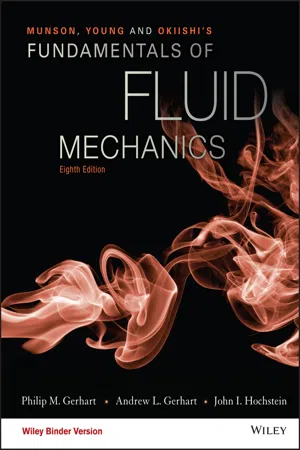Technology & Engineering
Buckingham Pi Theorem
The Buckingham Pi Theorem, also known as the π theorem, is a key concept in dimensional analysis. It states that if there are n variables and m fundamental dimensions, then there are n - m dimensionless π terms that can be formed. These dimensionless π terms can be used to express the relationships between the variables in a system, allowing for simplification and analysis.
Written by Perlego with AI-assistance
Related key terms
1 of 5
8 Key excerpts on "Buckingham Pi Theorem"
- Robert W. Fox, Alan T. McDonald, John W. Mitchell(Authors)
- 2020(Publication Date)
- Wiley(Publisher)
7.3 to see how practical and useful the method in fact is, before returning to reread the section. The Buckingham Pi Theorem is a statement of the relation between a function expressed in terms of dimensional parameters and a related function expressed in terms of nondimensional parameters. The Buckingham Pi Theorem allows us to develop the important nondimensional parameters quickly and easily.Fig. 7.1 Experimentally derived relation between the nondimensional parameters [3 , 15 , 16 ].7.1 Nondimensionalizing the Basic Differential Equations
Before developing a general approach to dimensional analysis let us see what we can learn from our previous analytical descriptions of fluid flow. Consider, for example, a steady incompressible two‐dimensional flow of a Newtonian fluid with constant viscosity. The mass conservation equation (Eq. 5.1c ) becomes(7.1)+∂ u∂ x= 0∂ υ∂ yand the Navier–Stokes equations (Eqs. 5.27 ) reduce to(7.2)andρu= −+ υ∂ u∂ x∂ u∂ y+ μ∂ p∂ x+∂ 2u∂x 2∂ 2u∂y 2(7.3)ρu= − ρ g −+ υ∂ υ∂ x∂ υ∂ y+ μ∂ p∂ y+∂ 2υ∂x 2∂ 2υ∂y 2As we discussed in Section 5.4 , these equations form a set of coupled nonlinear partial differential equations foru , υ, and p , and are difficult to solve for most flows. Equation 7.1 has dimensions of 1/time, and Eqs. 7.2 and 7.3 have dimensions of force/volume. Let us see what happens when we convert them into dimensionless equations.To nondimensionalize these equations, divide all lengths by a reference length, L , and all velocities by a reference speed,V ∞, which usually is taken as the freestream velocity. Make the pressure nondimensional by dividing byρV ∞ 2- Philip M. Gerhart, Andrew L. Gerhart, John I. Hochstein(Authors)
- 2016(Publication Date)
- Wiley(Publisher)
7.2 will be independent of the system of units we choose to use. This type of analysis is called dimensional analysis , and the basis for its application to a wide variety of problems is found in the Buckingham Pi Theorem described in the following section. 7.2 Buckingham Pi Theorem There are two fundamental questions that we must answer. The first is “Is Eq. 7.2 a fluke, or can we always reduce the number of variables by dimensional analysis? “The second is” How many dimensionless products are required to replace the original list of variables?” The answer to these questions is supplied by the basic theorem of dimensional analysis that states the following: If an equation involving k variables is dimensionally homogeneous, it can be reduced to a relationship among k − r independent dimensionless products, where r is the minimum number of reference dimensions required to describe the variables. Dimensionless products are important and useful in the planning, execution, and interpretation of experiments. D Δ p ℓ _____ V 2 ρ VD ____ μ ρ ■ Figure 7.2 An illustrative plot of pressure drop data using dimensionless parameters. 1 As noted in Chapter 1, we will use T to represent the basic dimension of time, although T is also used for temperature in thermodynamic relationships (such as the ideal gas law). The dimension of temperature is often represented by θ . 350 Chapter 7 ■ ■ Dimensional Analysis, Similitude, and Modeling The dimensionless products are frequently referred to as pi terms, and the theorem is called the Buckingham Pi Theorem . 2 Edgar Buckingham used the symbol Π to represent a dimensionless product, and this notation is commonly used. Although the pi theorem is a simple one, its proof is not so simple and we will not include it here. Many entire books have been devoted to the subject of similitude and dimensional analysis, and a number of these are listed at the end of this chapter (Refs. 1–15).- Robert W. Fox, Alan T. McDonald, John W. Mitchell(Authors)
- 2020(Publication Date)
- Wiley(Publisher)
These equations contain the physics of the situation and so are an important source of information. Next, in Section 7.2 we introduce the Buckingham Pi Theorem, a formalized procedure for deducing the dimensionless groups appropriate for a given fluid mechanics or other engi- neering problem. We suggest you read it once, then study Examples 7.1, 7.2, and 7.3 to see how practical and useful the method in fact is, before returning to reread the section. The Buckingham Pi Theorem is a 203 Learning Objectives statement of the relation between a function expressed in terms of dimensional parameters and a related function expressed in terms of nondimensional parameters. The Buckingham Pi Theorem allows us to develop the important nondimensional parameters quickly and easily. 7.1 Nondimensionalizing the Basic Differential Equations Before developing a general approach to dimensional analysis let us see what we can learn from our previous analytical descriptions of fluid flow. Consider, for example, a steady incompressible two- dimensional flow of a Newtonian fluid with constant viscosity. The mass conservation equation (Eq. 5.1c) becomes ∂u ∂x + ∂υ ∂y = 0 7 1 and the Navier–Stokes equations (Eqs. 5.27) reduce to ρ u ∂u ∂x + υ ∂u ∂y = − ∂p ∂x + μ ∂ 2 u ∂x 2 + ∂ 2 u ∂y 2 7 2 and ρ u ∂υ ∂x + υ ∂υ ∂y = − ρg − ∂p ∂y + μ ∂ 2 υ ∂x 2 + ∂ 2 υ ∂y 2 7 3 As we discussed in Section 5.4, these equations form a set of coupled nonlinear partial differential equations for u, υ, and p, and are difficult to solve for most flows. Equation 7.1 has dimensions of 1/time, and Eqs. 7.2 and 7.3 have dimensions of force/volume. Let us see what happens when we convert them into dimensionless equations. To nondimensionalize these equations, divide all lengths by a reference length, L, and all velocities by a reference speed, V ∞ , which usually is taken as the freestream velocity. Make the pressure nondi- mensional by dividing by ρV 2 ∞ (twice the freestream dynamic pressure).- John I. Hochstein, Andrew L. Gerhart(Authors)
- 2021(Publication Date)
- Wiley(Publisher)
1 As noted in Chapter 1, we will use T to represent the basic dimension of time, although T is also used for temperature in thermodynamic relationships (such as the ideal gas law). The dimension of temperature is often represented by θ. 7.3 Determination of Pi Terms 241 7.2 Buckingham Pi Theorem There are two fundamental questions that we must answer. The first is “Is Eq. 7.2 a fluke, or can we always reduce the number of variables by dimensional analysis?” The second is “How many dimensionless products are required to replace the original list of variables?” The answer to these questions is supplied by the basic theorem of dimensional analysis that states the following: If an equation involving k variables is dimensionally homogeneous, it can be reduced to a relationship among k − r independent dimensionless products, where r is the minimum number of reference dimensions required to describe the variables. The dimensionless products are frequently referred to as pi terms, and the theorem is called the Buckingham Pi Theorem. 2 Edgar Buckingham used the symbol Π to represent a dimension- less product, and this notation is commonly used. Although the pi theorem is a simple one, its proof is not so simple, and we will not include it here. Many entire books have been devoted to the subject of similitude and dimensional analysis, and a number of these are listed at the end of this chapter (Refs. 1–15). Students interested in pursuing the subject in more depth (including the proof of the pi theorem) can refer to one of these books. The pi theorem is based on the idea of dimensional homogeneity, which was introduced in Chapter 1. Essentially for any physically meaningful equation involving k variables, such as u 1 = f ( u 2 , u 3 , . . . , u k ) the dimensions of the variable on the left side of the equal sign must be equal to the dimensions of any term that stands by itself on the right side of the equal sign.- eBook - PDF
- Clive Dym(Author)
- 2004(Publication Date)
- Academic Press(Publisher)
Write out the Buckingham Pi Theorem as a series of steps, analogous to the steps described in the basic method on p. 23. Problem 2.8. Confirm eq. (2.28) by applying the basic method to the mixer problem. Problem 2.9. Confirm eq. (2.30) by applying the rest of the Buckingham Pi Theorem to the pendulum problem. Problem 2.10. Confirm eq. (2.32) by applying the rest of the Buckingham Pi Theorem to the revised formulation of the pendulum problem. Problem 2.11. Apply the Buckingham Pi Theorem to the revolution of two bodies in space, beginning with the functional equation (2.16). Problem 2.12. What happens when the Pi theorem is applied to the two-body problem, but beginning now with the functional equation (2.14)? 2.5 Systems of Units We have already noted that units are numerical measures derived from standards. Thus, units are fractions or multiples of those standards. The British system has long been the most commonly used system of units in the United States. In the British system, length is typically referenced in feet , force in pounds , time in seconds , and mass in slugs . The unit of pound force is defined as that force that imparts an acceleration of 32.1740 ft / sec 2 to a mass of 1/2.2046 of that piece of platinum known as the standard kilogram. While keeping in mind the distinction between dimensions and 2.5 Systems of Units 29 Table 2.3 The British and SI systems of units, including abbreviations and (approximate) conversion factors. - Nord-Eddine Sad Chemloul(Author)
- 2020(Publication Date)
- Wiley-ISTE(Publisher)
Non-dimensional numbers play an important role. Two questions therefore arise when considering a particular phenomenon:- – how many “dimensional numbers” should we use?
- – how can they be determined?
The answer to the first question is given by the Vaschy-Buckingham theorem or the theory of π.The answer to the second question is more difficult since there are several possible solutions. We need to choose the solutions that best represent the phenomenon: here, we can use certain well-known numbers as guides, such as the Reynolds number3 and the Froude number4 , which translate relationships of power. Then, experience and a good analysis of the phenomenon are indispensable.2.4.1 The Vaschy-Buckingham theoremWe will consider a physical phenomenon whose analysis makes it possible to create a list of physical quantities Gi that have an influence on this phenomenon. We can then assume that the following relationship exists:[2.6]Each of the physical quantities Gi can be expressed in a single way as a function of (n – 1) other quantities.Or conversely f (x1 ,x2 ,...,xk ) a subset of basic quantities sufficient to express the size of all quantities Gi under the form:[2.7]It is then shown that products such as:[2.8]in which Vi are the unknowns and must be dimensionless. Taking into account equation [2.7 ], the product [2.8 ] can be written as:[2.9]This product is therefore dimensionless if each of the exponents of the fundamental quantities is zero. We thus obtain a system of k algebraic equations containing the n unknowns Vi- Allan D. Kraus, James R. Welty, Abdul Aziz(Authors)
- 2011(Publication Date)
- CRC Press(Publisher)
Dimensional Analysis and Similarity 479 For now we are interested in two questions regarding the appropriate dimensionless pa-rameters: • How many are there? • What are they? Several methods exist for obtaining the answers to these questions and all of them have some common features. We will consider only one such procedure known as the Buckingham 1 method. The method consists of two parts that relate, in turn, to answering the questions of “How many are there?” and “What are they?” The procedure for answering the question “How many are there?” involves the use of a straightforward rule known as the Buckingham Pi Theorem , proposed in 1914. The designation, Pi, refers to the notation used for the dimensionless parameters, , which means “product of variables.” The idea is to first determine how many groups are to be formed from the primitive variables that pertain to a given physical situation. The Buckingham Pi Theorem is stated as i = n − r (15.1) where i = number of independent dimensionless groups n = number of variables involved r = rank of the dimensional matrix The dimensional matrix is formed by tabulating the exponents on the fundamental di-mensions, M, L, and T, which represent each variable involved. Example 15.1 provides an example of such a matrix and the evaluation of i, n, and r . Example 15.1 Determine the number of dimensionless groups needed to represent the variables involved in describing the effects of flow normal to a cylinder. The variables involved are the force, F , the diameter, d , the velocity, ˆ V , the density, , and the viscosity, . Solution The usual first step is to list all of the variables and their dimensional representation in the following form.- Ahlam I. Shalaby(Author)
- 2018(Publication Date)
- CRC Press(Publisher)
Thus, one may easily analytically/theoretically derive/formulate the mathematical model and apply the model without the need to calibrate or verify the model. Additionally, if one wishes to experimentally formulate, calibrate, and verify the theoretical mathematical model, one may use the dimensional analysis procedure itself (Buckingham π theorem) and the results of dimensional analysis (laws of dynamic similarity/similitude) to do so. The important role that dimensional analysis plays in the theoretical deterministic mathematical modeling is highlighted in the following five steps conducted in the modeling process. First, the dimensional analysis procedure itself (Buckingham π theorem) is used to formulate a mathematical model of the fluid flow situation by arranging/reducing the two or more significant variables (identified from the governing equations) into one dimensionless coefficient/ π term (π 1 = ϕ (nothing) = constant), which represents the uncalibrated mathematical model. The resulting dependent π term is a function of no other independent π terms and thus is equal to a constant. It is important to note that the dimensional analysis procedure is capable of reducing a large number of significant variables into one dimensionless coefficient/ π term (see Section 7.2.3), thus reducing the number of variables required to be calibrated (experimentally evaluated). Second, this uncalibrated mathematical model is ideally calibrated (i.e., the π term is evaluated) by conducting experiments using the full-scale physical prototype of the fluid flow situation. However, using the full-scale physical prototype to conduct experiments may present challenges such as inconvenient size (too large or too small), inconvenient fluids, economic constraints, time constraints, etc. Therefore, in order to solve this problem, one may instead design a geometrically scaled (either smaller or larger) physical model of the fluid flow situation
Index pages curate the most relevant extracts from our library of academic textbooks. They’ve been created using an in-house natural language model (NLM), each adding context and meaning to key research topics.







